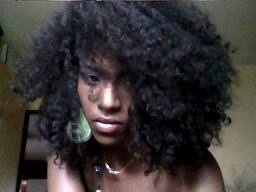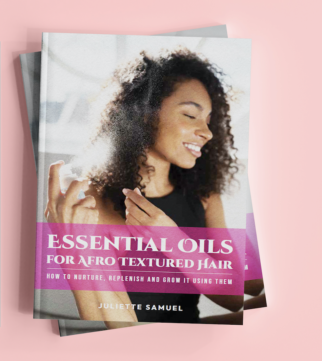
Does your bathroom cupboard look like a pharmacy? Do you gaze at the dizzying range of hair care products cluttering those shelves and see the evidence of years of trial and error: shampoos, conditioners, moisturizers – all promising to deliver healthy, growing natural hair? It can be a tricky and expensive business and when you add the issue of transitioning from relaxed state to natural state (help!), or hair texture, the whole business of hair care can be overwhelming.
How to Care for Natural Hair
There is no guaranteed road to a successful head of natural hair, but here are a few pointers that will make the journey smoother:
1.) Know your hair type. Don’t know for sure? Ask a good hairdresser.
Whether you are already natural-haired or are chemically-treated and looking to make the transition to natural hair, knowing your hair type allows you to zoom in on a practical strategy, weed out irrelevant product reviews or advice – and have realistic expectations of what your natural hair experience will be.
2.) Read labels closely and – if you can – smell the product before buying.
- Natural hair – regardless of texture – thrives on the right levels of moisture. You may find that many of your familiar shampoos, conditioners and maintenance products contain ingredients that are sabotaging the health of your tresses. For good natural hair care:
- Avoid alcohol. The list is long, but isopropyl alcohol, SD alcohol (40), alcohol denat and propyl alcohol are particularly damaging and will strip moisture from your hair. If you can detect alcohol when you sniff the product, don’t buy it.
- Avoid parabens. These preservatives are commonly used in skin care and hair care products. Research increasingly suggests possible health risks, particularly carcinogenic risks, associated with their use.
- Avoid sulphates (sulfates) – harsh chemicals that create the familiar foaming action in many shampoos (and toothpastes) that strip hair of vital moisture.
- Avoid petroleum. It simply coats the hair and does not allow it to breathe. Some experts also recommend avoiding mineral oil for similar reasons, while others maintain that it is a perfectly decent product that has been unfairly demonized. My opinion? Veto it
- Avoid fragrance. –If the ingredients are natural, you don’t need fragrance, which also dries the hair.
3.) Ditch the chemicals, and reach for the natural goodies.
- Shea butter and coconut oil are your friends. They are the best natural daily moisturizers, but beware of extravagant advertising claims. Some products contain negligible amounts of natural ingredients.
- Seek out essential oils for natural hair growth– use them on wet or dry hair to seal in moisture and protect against the elements, but remember: they tend to be highly concentrated and a little goes a long way. Try rosemary oil, jojoba oil, jasmine oil and argan oil, in particular. Apply lightly to the hair shaft and the ends once a week. (Twice, if you live in a very dry climate.) But allow your scalp to breathe, free of product (unless some scalp condition calls for specific product application).
- If you prefer to create your own natural hair care products and need water as an ingredient, use the distilled or de-ionized variety (available in most supermarkets or pharmacies). This water is free of copper or harmful deposits that can dry your hair and shorten the shelf life of your concoctions.
- Want to experiment with hair color? Unless you are an experienced do-it-yourselfer, proceed with caution and consult a good hair colorist first. Avoid ammonia at all costs and stick to vegetable or henna dyes. Be extra careful when dyeing sisterlocks – dyes can break fragile, tiny locks.
4.) Protect against sun and sea.
- Style your natural hair in ways that protect the ends (which are most susceptible to drying from the environment): try cornrows, twists and buns.
- Before swimming in pools (warning: chlorine is your enemy) or the sea, coat your hair in your favorite rinse-off moisturizer. Rinse hair thoroughly as soon as you are finished swimming.
- Consider sleeping on a silk or satin pillow or in a silk cap; it is less abrasive to the hair shaft than cotton or polyester.
5.) Don’t over-wash.
To figure out the best hair washing regime, factor in your hair type, length, style, the condition of your scalp, and your life style and choose the right kind of shampoo. Generally, natural hair flourishes if washed no more than once a week, but if you have locks, for example, your technician may advise that washing once every two weeks is ideal. Many natural hairstylists stress the importance of scalp sebum for nourishing the hair follicles and hair shaft – over-washing rinses this away.
If you like to keep things quick and simple, investigate co-washes: an increasingly popular one-step shampoo and conditioner option. Whatever your regime, handle wet hair with loving care – do not rub the strands. Stroke any product through the hair, rinse very thoroughly and gently blot dry.
6.) Don’t buy the kitchen sink.
If you’re on a budget, or just want to cut down on maintenance time, buy these three products:
a) a good moisturizing co-wash;
b) a coconut oil or Shea butter moisturizer;
c) rosemary oil or jojoba oil to seal in moisture.
Relaxed to Natural: Making the Great Transition
Dramatically referred to as the Big Chop, many of us know the bittersweet experience of saying goodbye to relaxed tresses to go natural. If you know you can’t just lop off your relaxed hair and step out rocking a short ‘fro, here are five steps to a gentle transition:
1.) Concentrate moisture on the new natural hair growth
Transitioning creams are now increasingly available to help with natural hair care, but any good, light moisturizing lotion (as opposed to a heavy cream) will do the same job. Condition roots thoroughly after every shampoo.
2.) Trim split ends
Trimming the ends every six weeks can help limit breakage caused having two different textures.
3.) Avoid protein treatments
Protein treatments are often misused, misunderstood and counter-productive. Consult with a good hairdresser over the correct use of protein treatments during this critical phase to avoid hair loss and breakage.
4.) Avoid heat appliances, roller sets, over-combing, over-brushing and over-pulling
Your hair is the most fragile where the two textures meet. Don’t stress the situation. Use a wide-tooth comb, and never brush while wet.
5.) Consider faking it until you make it
If you can’t bear the two-texture look or your hair just refuses to behave, consider wearing cornrows, braid extensions or a weave (no glue, please!) during the transition. But do not neglect your roots. Find or create a good moisturizing spray or lotion and apply it diligently to your new growth.
That’s it for this week. As always …
Dedicated to Your Beauty. Good luck!
Juliette Samuel
Esthetician/Author/Publisher/Aromatherapist




 Facebook
Facebook Twitter
Twitter Delicious
Delicious Digg
Digg Myspace
Myspace StumbleUpon
StumbleUpon Youtube
Youtube